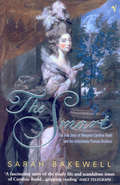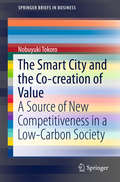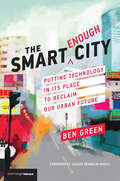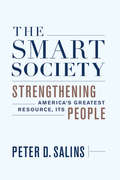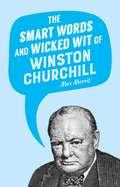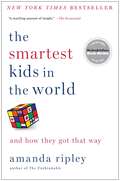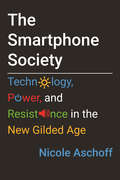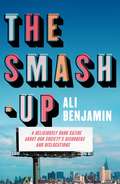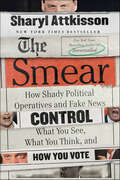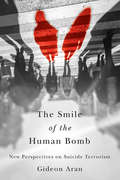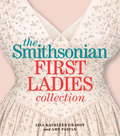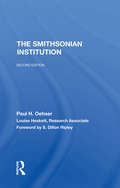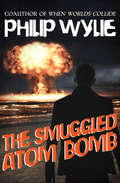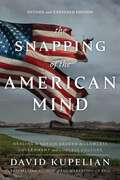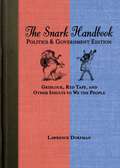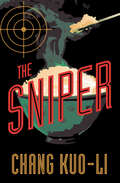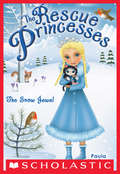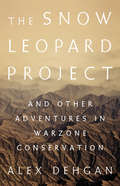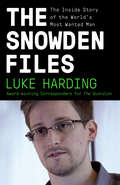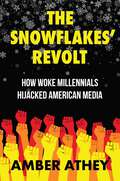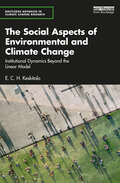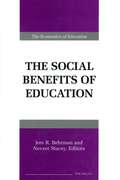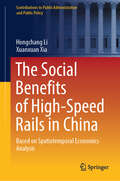- Table View
- List View
The Smart
by Sarah BakewellThe Smart is a true drama of eighteenth-century life with a mercurial, mysterious heroine. Caroline is a young Irishwoman who runs off to marry a soldier, comes to London and slides into a glamorous life as a high-class prostitute, a great risk-taker, possessing a mesmerising appeal. In the early 1770s, she becomes involved with the intriguing Perreau twins, identical in looks but opposite in character, one a sober merchant, the other a raffish gambler. They begin forging bonds, living in increasing luxury until everything collapses like a house of cards - and forgery is a capital offence. A brilliantly researched and marvellously evocative history, The Smart is full of the life of London streets and shots through with enduring themes - sex, money, death and fame. It bridges the gap between aristocracy and underworld as eighteenth-century society is drawn into the most scandalous financial sting of the age.
The Smart City and the Co-creation of Value
by Nobuyuki TokoroThe original point that differentiates this text from otherwise similar texts is that it looks at the building of smart cities from the viewpoint of an interchange of knowledge among companies in different industries, or "Ba" as shared context in motion, and emphasizes that the resulting value becomes a source of new corporate competitive advantage. In recent years numerous publications have appeared that analyze smart cities from various perspectives including urban planning and administration, network theory, and innovation. However, few are academic texts that approach the subject from the viewpoint of corporate competitive advantage against a theoretical background in management studies, as this one does. This book is the first full-scale academic work to analyze smart cities from the viewpoint of corporate competitive advantage. Research into corporate competitive advantage includes the positioning and the resource-based views, with the former focusing on companies' external environment and the latter on their internal resources. Although these theories' foci of attention necessarily differ, they both developed as tools for analyzing companies' relative merits and their chances of succeeding in the marketplace, and they take the common premise that competitive advantage is built through competition among companies. In contrast, this book sees corporate competitive advantage as arising not through competition but through "co-creation" among companies. It differs in its approach from existing theories in thinking that emphasizing co-creation over competition enables an analysis that better describes actual conditions when considering smart cities and corporate competitive advantage. Put another way, when new values arise from attempts to exchange and fuse knowledge, expertise, and other factors at the "ba" where companies from different industries collaborate, these values are surely brought about through co-creation among companies. Another point regarding this book's original perspective on competitive advantage is its emphasis on the relationship between the creation of social value and competitive advantage. The question of the extent to which socially useful values can be created in the markets of the 21st century is closely linked to corporate competitive advantage. The issues of building smart cities and corporate competitive advantage are themes that this perspective can firmly grasp. This book intends to take up three different projects from among the smart-city building developments taking shape in Japan, and undertake case studies based on the theoretical framework outlined above. The central themes will analyze the mechanism of co-creation among companies and the relationship of created value to competitive advantage. This analysis aims to demonstrate one model relating to corporate competitive advantage in the 21st century.
The Smart Enough City: Putting Technology in Its Place to Reclaim Our Urban Future (Strong Ideas)
by Ben GreenWhy technology is not an end in itself, and how cities can be “smart enough,” using technology to promote democracy and equity.Smart cities, where technology is used to solve every problem, are hailed as futuristic urban utopias. We are promised that apps, algorithms, and artificial intelligence will relieve congestion, restore democracy, prevent crime, and improve public services. In The Smart Enough City, Ben Green warns against seeing the city only through the lens of technology; taking an exclusively technical view of urban life will lead to cities that appear smart but under the surface are rife with injustice and inequality. He proposes instead that cities strive to be “smart enough”: to embrace technology as a powerful tool when used in conjunction with other forms of social change—but not to value technology as an end in itself.In a technology-centric smart city, self-driving cars have the run of downtown and force out pedestrians, civic engagement is limited to requesting services through an app, police use algorithms to justify and perpetuate racist practices, and governments and private companies surveil public space to control behavior. Green describes smart city efforts gone wrong but also smart enough alternatives, attainable with the help of technology but not reducible to technology: a livable city, a democratic city, a just city, a responsible city, and an innovative city. By recognizing the complexity of urban life rather than merely seeing the city as something to optimize, these Smart Enough Cities successfully incorporate technology into a holistic vision of justice and equity.
The Smart Society
by Peter D. SalinsThe Smart Society offers a detailed blueprint for how the United States can recast its human capital policies to make all Americans-not just a privileged elite-smarter and more successful than ever before, at the same time stemming the size and cost of the nation's "safety net." The spectacular, centuries-long success of the United States is based on its having determined, early on, to be a smart country, single-mindedly developing institutions and practices that enabled its native born citizens to maximize their economic and social potential, and welcoming opportunity-seeking foreigners to join them. Over the last four decades, however, the vaunted United States human capital machine has been breaking down, dimming the economic and social prospects of millions of Americans.If The Smart Society blueprint is followed, these trends can be reversed and the nation and its people can quickly regain their preeminence in the hyper-competitive and globalized world of the 21st century. This is a most topical issue today because the country's current heated political disagreements are not just about the proper size of government, but about how the United States can reverse its apparent decline and restore its historic economic and social vigor-in other words, regain its place as the world's "smartest" nation.
The Smart Words and Wicked Wit of Winston Churchill
by Max Morris"For myself I am an optimist,” said legendary British politician Winston Churchill. "It does not seem to be much use being anything else.”Have you ever wanted to deliver the ultimate Churchillian wisecrack? Give sound advice to a peer on how to deal with life’s problems? Or contribute to a heated discussion on international politics? The Smart Words and Wicked Wit of Winston Churchill is the perfect pocket book to carry around in your arsenal as you laugh at Churchill’s devious brand of smarts and learn from his political and humanist outlook on life during the turmoil of the Second World War. Discover what he had to say about domestic politics, war and peace, power, struggles and strife, education, philosophy, and some of the biggest names of his time, including himself.Beautifully designed and curated, this entertaining collection compiles the wisest and wittiest Churchill quotations that speak of the politician’s enduring legacy in contemporary pop culture. Full of savvy and wisdoms, The Smart Words and Wicked Wit of Winston Churchill is sure to delight devoted fans of history and casual readers alike.
The Smartest Kids in the World: And How They Got That Way
by Amanda RipleyHow do other countries create &“smarter&” kids? What is it like to be a child in the world&’s new education superpowers? The Smartest Kids in the World &“gets well beneath the glossy surfaces of these foreign cultures and manages to make our own culture look newly strange....The question is whether the startling perspective provided by this masterly book can also generate the will to make changes&” (The New York Times Book Review).In a handful of nations, virtually all children are learning to make complex arguments and solve problems they’ve never seen before. They are learning to think, in other words, and to thrive in the modern economy. Inspired to find answers for our own children, author and Time magazine journalist Amanda Ripley follows three Americans embedded in these countries for one year. Kim, fifteen, raises $10,000 so she can move from Oklahoma to Finland; Eric, eighteen, trades his high-achieving Minnesota suburb for a booming city in South Korea; and Tom, seventeen, leaves a historic Pennsylvania village for Poland. Through these young informants, Ripley meets battle-scarred reformers, sleep-deprived zombie students, and a teacher who earns $4 million a year. Their stories, along with groundbreaking research into learning in other cultures, reveal a pattern of startling transformation: none of these countries had many “smart” kids a few decades ago. Things had changed. Teaching had become more rigorous; parents had focused on things that mattered; and children had bought into the promise of education.
The Smartphone Society: Technology, Power, and Resistance in the New Gilded Age
by Nicole AschoffAddresses how tech empowers community organizing and protest movements to combat the systems of capitalism and data exploitation that helped drive tech's own rise to ubiquity.Our smartphones have brought digital technology into the most intimate spheres of life. It's time to take control of them, repurposing them as pathways to a democratically designed and maintained digital commons that prioritizes people over profit. Smartphones have appeared everywhere seemingly overnight: since the first iPhone was released, in 2007, the number of smartphone users has skyrocketed to over two billion. Smartphones have allowed users to connect worldwide in a way that was previously impossible, created communities across continents, and provided platforms for global justice movements. However, the rise of smartphones has led to corporations using consumers' personal data for profit, unmonitored surveillance, and digital monopolies like Google, Facebook, and Amazon that have garnered control over our social, political, and economic landscapes.But people are using their smartphones to fight back. New modes of resistance are emerging, signaling the possibility that our pocket computers could be harnessed for the benefit of people, not profit. From helping to organize protests against the US-Mexico border wall through Twitter to being used to report police brutality through Facebook Live, smartphones open a door for collective change.
The Smash-Up: a delicious satire from a breakout voice in literary fiction
by Ali BenjaminAN OF-THE-MOMENT NOVEL FOR READERS OF FLEISHMAN IS IN TROUBLE'Timely, risky and dazzling' Polly Clark, author of Tiger'Sharply funny, perceptive, and surprising at every turn, The Smash-Up is a story that's acid-etched and full of heart, intimate, and relevant' Amy Bloom, New York Times bestselling author of White Houses and Away'Every woman should read this book. Every woman, every feminist, every activist' Jane Harris, author of Orange Prize shortlisted The ObservationsAfter years spent in the city, working with his business partner Randy on Bränd media, Ethan finds himself in the quiet, closed-off town of Starkfield. His wife Zenobia is perpetually distracted by the swirling #MeToo politics, the Kavanaugh hearings, and her duties to the feminist activism group she formed: All Them Witches. Ethan finds himself caught between their regular meetings at his home and the battle to get his livewire daughter Alex to sleep.But the new, stilted rhythm of his life is interrupted when he receives a panicked message. Accusations. Against Randy. A slew of them. And Ethan is abruptly forced to question everything: his past, his future, his marriage, and what he values most.Unrelenting in its satire, The Smash-up jolts you into the twisted psyche of successful brand advertising, where historic exploitation is only ever a panicked phone-call away. With magnetic energy and doses of comic wit, Benjamin creates a world of social media algorithms, extreme polarization, the collapsing of identity into tweet-sized spaces, and the spectre of violence that can be found even in the quietest places.
The Smear: How Shady Political Operatives and Fake News Control What You See, What You Think, and How You Vote
by Sharyl AttkissonNew York Times BestsellerEver wonder how politics turned into a take-no-prisoners blood sport? The New York Times bestselling author of Stonewalled pulls back the curtain on the shady world of opposition research and reveals the dirty tricks those in power use to influence your opinions.Behind most major political stories in the modern era, there is an agenda; an effort by opposition researchers, spin doctors, and outside interests to destroy an idea or a person. The tactic they use is the Smear. Every day, Americans are influenced by the Smear without knowing it. Paid forces cleverly shape virtually every image you cross. Maybe you read that Donald Trump is a racist misogynist, or saw someone on the news mocking the Bernie Sanders campaign. The trick of the Smear is that it is often based on some shred of truth, but these media-driven "hit pieces" are designed to obscure the truth. Success hinges on the Smear artist’s ability to remain invisible; to make it seem as if their work is neither calculated nor scripted. It must appear to be precisely what it is not.Veteran journalist Sharyl Attkisson has witnessed this practice firsthand. After years of being pitched hit jobs and puff pieces, she’s an expert at detecting Smear campaigns. Now, the hard-hitting investigative reporter shares her inside knowledge, revealing how the Smear takes shape and who its perpetrators are—including Clinton confidant Sidney Blumenthal and, most influential of all, "right-wing assassin turned left-wing assassin" (National Review) political operative David Brock and his Media Matters for America empire.Attkisson exposes the diabolical tactics of Smear artists, and their outrageous access to the biggest names in political media—operatives who are corrupting the political process, and discouraging widespread citizen involvement in our democracy.
The Smile of the Human Bomb: New Perspectives on Suicide Terrorism
by Gideon AranIn 2017, nearly six thousand people were killed in suicide attacks across the world.In The Smile of the Human Bomb, Gideon Aran dissects the moral logic of the suicide terrorism that led to those deaths. The book is a firsthand examination of the bomb site at the moment of the explosion, during the first few minutes after the explosion, and in the last moments before the explosion. Aran uncovers the suicide bomber’s final preparations before embarking on the suicide mission: the border crossing, the journey toward the designated target, penetration into the site, and the behavior of both sides within it. The book sheds light on the truth of the human bomb.Aran’s gritty and often disturbing account is built on a foundation of participant observation with squads of pious Jewish volunteers who gather the scorched fragments of the dead after terrorist attacks; newly revealed documents, including interrogation protocols; interviews with Palestinian armed resistance members and retired Israeli counterterrorism agents; observations of failed suicide terrorists in jail; and conversations with the acquaintances of human bombs.The Smile of the Human Bomb provides new insights on the Middle East conflict, political violence, radicalism, victimhood, ritual, and death and unveils a suicide terrorism scene far different from what is conventionally pictured. In the end, Aran discovers, the suicide terrorist is an unremarkable figure, and the circumstances of his or her recruitment and operation are prosaic and often accidental. The smiling human bomb is neither larger than life nor a monster, but an actor on a human scale. And suicide terrorism is a drama in which clichés and chance events play their role.
The Smithsonian First Ladies Collection
by Amy Pastan Lisa Kathleen GraddyAdmire the nationally famous collection of first ladies' gowns and learn about the contributions made by the women who wore themThe Smithsonian First Ladies Collection is a beautifully illustrated book inspired by one of the most popular attractions at the Smithsonian: the first ladies exhibit at the National Museum of American History. This striking book showcases the treasures from first ladies throughout history, ranging from Martha Washington's silk dress and dressing mirror to Michelle Obama's 2009 inaugural gown and jewelry. These and many other unforgettable objects--including gowns, tableware, and invitations from beloved first ladies such as Mamie Eisenhower, Jacqueline Kennedy, Barbara Bush, Hilary Clinton, and more--tell the story of the first ladies as public and private figures. They illustrate how these women, thrust into an influential and visible role by happenstance of marriage, adapted themselves and the role of first lady by taking on responsibilities as campaigners, hostesses, and policy advocates.The Smithsonian First Ladies Collection features many treasures not on view at the exhibit. Complete with an insider's look at the acquisition, conservation, and exhibition of the pieces as well as a timeline of all forty-six first ladies, this is a must-have for anyone fascinated by these incredible women and their roles in American culture and political life.
The Smithsonian Institution: Second Edition
by Paul H. Oehser Louise HeskettThe Smithsonian Institution has grown and prospered since the first edition of this book appeared in 1970, and Paul Oehser's revised edition is badly needed. New and expanded structures (the Air and Space Museum, the Hirshhorn, the National Museum of American Art, the National Portrait Gallery) and new undertakings (Smithsonian magazine, the Handbook of North American Indians series, the Woodrow Wilson Center, and prestigious symposia) richly serve the original purpose James Smithson envisioned in his will: " To found at Washington, under the name of the Smithsonian Institution, an establishment for the increase and diffusion of knowledge among men." The heart of Oehser's original work has been left intact in this second edition. His is the only survey that combines the dramatic story of the Smithsonian's influence and expansion with the behind-the-scenes details of daily operations, structure, and administrative problems. The book has been updated to include all important developments of the last thirteen years, as well as to describe current plans for future expansion and program additions. The whole picture leads one to the conclusion that the world's largest museum complex, housing over seventy million objects, has succeeded—despite its air of old-fashioned traditionalism—in reflecting the adventure of the American experience and the insatiable curiosity and dynamics of the American spirit.
The Smuggled Atom Bomb
by Philip WylieA graduate student stumbles across an insidious plot to unleash nuclear terror on America's greatest cities in a blood-chillingly prescient tale from one of thriller fiction's twentieth-century masters Personable, good-looking, and a whiz at physics, graduate student Allan Diffenduffer "Duff" Bogan has a bright future ahead of him. But while staying at the home of an invalid widow in Florida, Duff makes a discovery that freezes his blood: a cache of uranium hidden in the locked closet of a fellow guest. The FBI is initially skeptical, but Duff knows all too well what his findings portend. Suddenly, not only is his future in jeopardy, the fate of millions of Americans hangs in the balance as well. If he cannot expose the horrific plot his nation's enemies set in motion years before, entire cities will be reduced to piles of radioactive rubble in an unthinkable nuclear nightmare stretching from coast to coast. And time, it seems, is rapidly running out.
The Snapping of the American Mind: Healing a Nation Broken by a Lawless Government and Godless Culture
by David KupelianAmerica the beautiful has become America the bizarre.REVISED AND EXPANDED EDITION! "A must-read if you really want to understand the world we live in and where it's headed." – SEAN HANNITY "David Kupelian's The Snapping of the American Mind chronicles the decline and fall of America and shows that it is no accident, but rather a direct result of progressive misrule?an eye-opening, scary and galvanizing book." – DINESH D'SOUZA "David Kupelian has once again given us a must-read in these times of political turbulence and cultural insanity." – PAUL KENGOR America the beautiful has become America the bizarre. Government promotes shockingly deranged policies while purposely turning citizens against each other, Christians are prosecuted as criminals, children "transition" to the opposite sex, crime skyrockets and 130 million Americans depend on mind-altering substances just to get through life. Turbocharged by the Obama presidency and continuing into the present day, long-coalescing forces of the political and cultural Left are bringing about their much-heralded "fundamental transformation of America." That much everyone knows. But this revolution is also causing a fundamental transformation of Americans in profoundly negative ways. In The Snapping of the American Mind, veteran journalist and bestselling author David Kupelian shows how the progressive Left which today dominates America's key institutions, from the news and entertainment media, to Big Tech, to education, to government itself is accomplishing much more than just enlarging government, redistributing wealth, and de-Christianizing the culture. With the Left's wild celebration of sexual anarchy, its intimidating culture of political correctness, and its incomprehension of the fundamental sacredness of human life, it is also, whether intentionally or not, promoting widespread dependency, debauchery, family breakdown, crime, corruption, addiction, despair, and suicide. Surveying this growing chaos in American society, Kupelian exposes both the utopian revolutionaries and their extraordinary methods that have turned America's most cherished values literally upside down to the point that madness is celebrated and normality demonized.
The Snares: A Novel
by Rav Grewal-KökA Punjabi American lawyer at a mysterious federal intelligence agency fights to keep his career, marriage, and morality intact in this gripping post-9/11 drama from a thrilling new voice. &“Here is, at long last, our immigrant John le Carré. . . . Rav Grewal-Kök is a fearless and visionary writer.&”—Xuan Juliana Wang, author of Home Remedies&“Are you happy where you are? Toiling in the trenches of the Justice Department?&”In the waning months of George W. Bush&’s presidency, Neel Chima, a former naval officer and federal prosecutor, is recruited to join a new federal intelligence agency—one with greater than usual powers and fewer than usual restrictions. Neel soon finds himself intimately involved in the surveillance of domestic terrorism suspects and the selection of foreigners for drone assassination—men who often look just like his Sikh family members. As both his ambitions and his moral qualms mount, he is drawn farther and farther away from his wife and two young daughters. When he makes a critical mistake at work, he is left vulnerable to shadowy figures in the intelligence world who seek to use him in their own, still more radical counterterrorism missions. If he agrees, the world of power will open up even wider to him. If he doesn&’t . . .Is Neel an insider or an outsider? The hunter or the hunted? An idealist or a mercenary? What truths, and whose lives, is he willing to sacrifice? The novel plunges readers into the human turmoil behind the faceless operations—the torture, secret assassinations, and drone strikes—of the American security state, creating an eye-opening meditation on morality, violence, and the price of a human soul.
The Snark Handbook: Politics and Government Edition (Snark Series)
by Lawrence DorfmanAnother political year is upon us . . . a year in which we elect another useless figurehead to piss off the masses, confuse the classes, and, above all, reward the jackasses. It will be a time of fear, angst, and anger, the perfect moment for The Snark Handbook: Politics and Government Edition. Filled with quotes, jokes, and timeless snarks, this brave foray into the political theater, old and new, will serve as a priceless source of sanity as you navigate the asylum. In the same inimitable style as the previous bestselling Snark titles, this timely entry is guaranteed to amuse and entertain. The wit and humor of Lawrence Dorfman shines in this collection, where he highlights the ineptitude and malice that is American democracy. You'll see first-hand the shenanigans that started with our Founding Fathers and still continue bravely on today. Hail to the Chief!
The Sniper
by Kuo-Li ChangJason Bourne meets John McClane in this electrifying thriller about a special-forces sniper and a seasoned homicide detective who get caught up in a criminal conspiracy that involves the highest levels of power. Twelve days before retirement, Taipei police detective Wu is handed a curious case: a naval officer has been found dead in his hotel room. While it is immediately apparent to Wu that the officer has been murdered, the military insist it was suicide and want the case closed with no questions asked. Soon, however, more high-ranking officers turn up dead, and Wu realizes he has a full-blown conspiracy on his hands. Meanwhile in Italy, Alex, a young Taiwanese sniper, ex-Marine, ex–French Foreign Legion, and currently a fried-rice chef in Manarola, is called back into service. Ordered by his handler to assassinate a high-level Taiwanese government advisor in Rome, he soon finds himself on the run, hunted across Europe by his old brothers-in-arms.
The Snow Jewel: The Snow Jewel (The Rescue Princesses #5)
by Paula HarrisonThese are no ordinary princesses--they're Rescue Princesses!Northernland is the snowiest kingdom the Rescue Princesses have ever visited. They are delighted to go sledding, drink hot cocoa, and make friends with the girl who lives there, Princess Freya. When Princess Freya's mischievous kitten goes missing, the princesses leap into action. They have to find the kitten-even if it means letting Freya in on their Rescue Princess secret.
The Snow Leopard Project: And Other Adventures in Warzone Conservation
by Alex DehganThe remarkable story of the heroic effort to save and preserve Afghanistan's wildlife-and a culture that derives immense pride and a sense of national identity from its natural landscape.Postwar Afghanistan is fragile, volatile, and perilous. It is also a place of extraordinary beauty. Evolutionary biologist Alex Dehgan arrived in the country in 2006 to build the Wildlife Conservation Society's Afghanistan Program, and preserve and protect Afghanistan's unique and extraordinary environment, which had been decimated after decades of war.Conservation, it turned out, provided a common bond between Alex's team and the people of Afghanistan. His international team worked unarmed in some of the most dangerous places in the country-places so remote that winding roads would abruptly disappear, and travel was on foot, yak, or mule. In The Snow Leopard Project, Dehgan takes readers along with him on his adventure as his team helps create the country's first national park, completes the some of the first extensive wildlife surveys in thirty years, and works to stop the poaching of the country's iconic endangered animals, including the elusive snow leopard. In doing so, they help restore a part of Afghan identity that is ineffably tied to the land itself.
The Snowden Files
by Luke HardingIT BEGAN WITH A TANTALIZING, ANONYMOUS EMAIL: "I AM A SENIOR MEMBER OF THE INTELLIGENCE COMMUNITY." What followed was the most spectacular intelligence breach ever, brought about by one extraordinary man. Edward Snowden was a 29-year-old computer genius working for the National Security Agency when he shocked the world by exposing the near-universal mass surveillance programs of the United States government. His whistleblowing has shaken the leaders of nations worldwide, and generated a passionate public debate on the dangers of global monitoring and the threat to individual privacy. In a tour de force of investigative journalism that reads like a spy novel, award-winning Guardian reporter Luke Harding tells Snowden's astonishing story--from the day he left his glamorous girlfriend in Honolulu carrying a hard drive full of secrets, to the weeks of his secret-spilling in Hong Kong, to his battle for asylum and his exile in Moscow. For the first time, Harding brings together the many sources and strands of the story--touching on everything from concerns about domestic spying to the complicity of the tech sector--while also placing us in the room with Edward Snowden himself. The result is a gripping insider narrative--and a necessary and timely account of what is at stake for all of us in the new digital age.From the Trade Paperback edition.
The Snowden Files: The Inside Story of the World's Most Wanted Man
by Luke HardingIT BEGAN WITH A TANTALIZING, ANONYMOUS EMAIL: "I AM A SENIOR MEMBER OF THE INTELLIGENCE COMMUNITY." What followed was the most spectacular intelligence breach ever, brought about by one extraordinary man. Edward Snowden was a 29-year-old computer genius working for the National Security Agency when he shocked the world by exposing the near-universal mass surveillance programs of the United States government. His whistleblowing has shaken the leaders of nations worldwide, and generated a passionate public debate on the dangers of global monitoring and the threat to individual privacy. In a tour de force of investigative journalism that reads like a spy novel, award-winning Guardian reporter Luke Harding tells Snowden's astonishing story--from the day he left his glamorous girlfriend in Honolulu carrying a hard drive full of secrets, to the weeks of his secret-spilling in Hong Kong, to his battle for asylum and his exile in Moscow. For the first time, Harding brings together the many sources and strands of the story--touching on everything from concerns about domestic spying to the complicity of the tech sector--while also placing us in the room with Edward Snowden himself. The result is a gripping insider narrative--and a necessary and timely account of what is at stake for all of us in the new digital age.
The Snowflakes' Revolt: How Woke Millennials Hijacked American Media
by Amber AtheyThe &“snowflake&” generation of college students didn&’t simply melt away as expected, but rather, entered the workforce and hijacked mainstream media, using campus mob intimidation tactics to push America further to the left than ever before.Step onto a college campus, attend a street protest, flip to a legacy news network, tune in to a White House press briefing, and you&’re likely to come down with a bad case of déjà vu. The media—composed almost entirely of liberal elites—along with the Democratic Party and its activists have long worked in tandem to make their ideas palatable to the public. But the media&’s reliance on the left for relevance had an unwanted side effect: it&’s been forced to genuflect to the most radical and most obnoxious—and, unfortunately, very influential—activists. Over the past decade, the zealous individuals once derided as college &“snowflakes&” by the right have taken over key cultural institutions, pushing the national conversation further to the left than ever before. These individuals have cohered into a potent clique that has employed campus mob tactics to orchestrate revolutions (and purges) at the New York Times, major publishing companies, and mega-corporations in Silicon Valley and beyond. Low-level staffers transform into Slacktivists, organizing protests through their company social media channels and WhatsApp group chats, eventually collecting enough digital signatures to wrestle management into submission. Amber Athey has witnessed it all come to fruition. She was the most vocal conservative at Georgetown University when academic freedom was first being suffocated by safe spaces and trigger warnings. After graduation, she covered liberal bias at colleges across the country, binged endless hours of cable news each day as a media reporter, and most recently embedded with the White House press corps as a correspondent. Part memoir, part investigation, and part prescription, this book will expose how modern media influences the American public with the coordinated assistance of left-wing politicians, think tanks, special interest groups, and &“experts.&” Finally, The Snowflakes&’ Revolt will argue that the introduction of petulant radicals to this already volatile concoction will only accelerate the media&’s collapse.
The Social Aspects of Environmental and Climate Change: Institutional Dynamics Beyond a Linear Model (Routledge Advances in Climate Change Research)
by E. C. KeskitaloThe Social Aspects of Environmental and Climate Change critically examines the prominence of natural science framing in mainstream climate change research and demonstrates why climate change really is a social issue. The book highlights how assumptions regarding social and cultural systems that are common in sustainability science have impeded progress in understanding environmental and climate change. The author explains how social sciences theory and perspectives provide an understanding of institutional dynamics including issues of scale, possibilities for learning, and stakeholder interaction, using specific case studies to illustrate this impact. The book highlights the foundational role research into social, political, cultural, behavioural, and economic processes must play if we are to design successful strategies, instruments, and management actions to act on climate change. With pedagogical features such as suggestions for further reading, text boxes, and study questions in each chapter, this book will be an essential resource for students and scholars in sustainability, environmental studies, climate change, and related fields.
The Social Benefits of Education
by Jere R. Behrman Nevzer StaceyFor decades, the primary argument in justifying education has been based on its direct economic effects. Yet education also provides "social benefits" for individuals and society at large, including a better way of taking care of ourselves, and consequently creating a better society to live in. Though it is difficult to quantify these social benefits, a more systematic analysis would improve our understanding of the full effects of education and provide a basis for considering related policies. The Office of Research of the United States Department of Education commissioned a series of papers on measuring these effects of education. Those papers, revised and updated, are collected here. Kenneth J. Arrow provides perspective on education and preference formation, and Jere R. Behrman considers general conceptual and measurement issues in assessing the social benefits of education and policies related to education. These issues are taken up by experts in four fields--health, parenting, the environment, and crime. Themes addressed include measurement issues regarding what we mean by education and its benefits; basic analytical issues in assessing the impact of education on these social benefits using behavioral data; and whether the social benefits of education justify public policy interventions. Jere R. Behrman is William R. Kenan Jr. Professor of Economics, University of Pennsylvania. Nevzer G. Stacey is Senior Research Analyst, Office of Educational Research, U. S. Department of Education.
The Social Benefits of High-Speed Rails in China: Based on Spatiotemporal Economics Analysis (Contributions to Public Administration and Public Policy)
by Hongchang Li Xuanxuan XiaThis book summarizes the quantitative research methods related to the social benefits of high-speed rails. It also explores the political, economic, technological, social and environmental impacts of high-speed rails. As China's new national business card, high-speed railways not only reflect the advanced technology of Chinese railways but also reflect China's increasing comprehensive national power. The highlight of the book is to conduct multidimensional analysis of the social benefits of the high-speed rail with a focus of spatiotemporal economics analysis.
